Evidence Based Practice: Randomized Control Trial Analysis Report
VerifiedAdded on 2020/04/15
|14
|3335
|52
Report
AI Summary
This report provides a critical appraisal of a randomized control trial (RCT) aimed at preventing infant cry and sleep problems, and postnatal depression. The study, conducted in Melbourne, Australia, involved 781 infants and their caregivers, with an intervention group receiving instructions on cry patterns, infant sleep, and parental self-care, compared to a control group. The analysis assesses the trial's methodology, including randomization, blinding, and participant characteristics. Key findings include the impact of frequent feeding on sleep and crying, and the benefits of caregiver education in reducing depression symptoms and improving mental health. The report also includes a PICOT analysis, highlighting the population, intervention, comparison, and outcomes of the study. The report concludes with a discussion of the study's limitations and its relevance to broader healthcare practices, emphasizing the importance of considering socio-economic factors and the specific needs of frequent feeders.
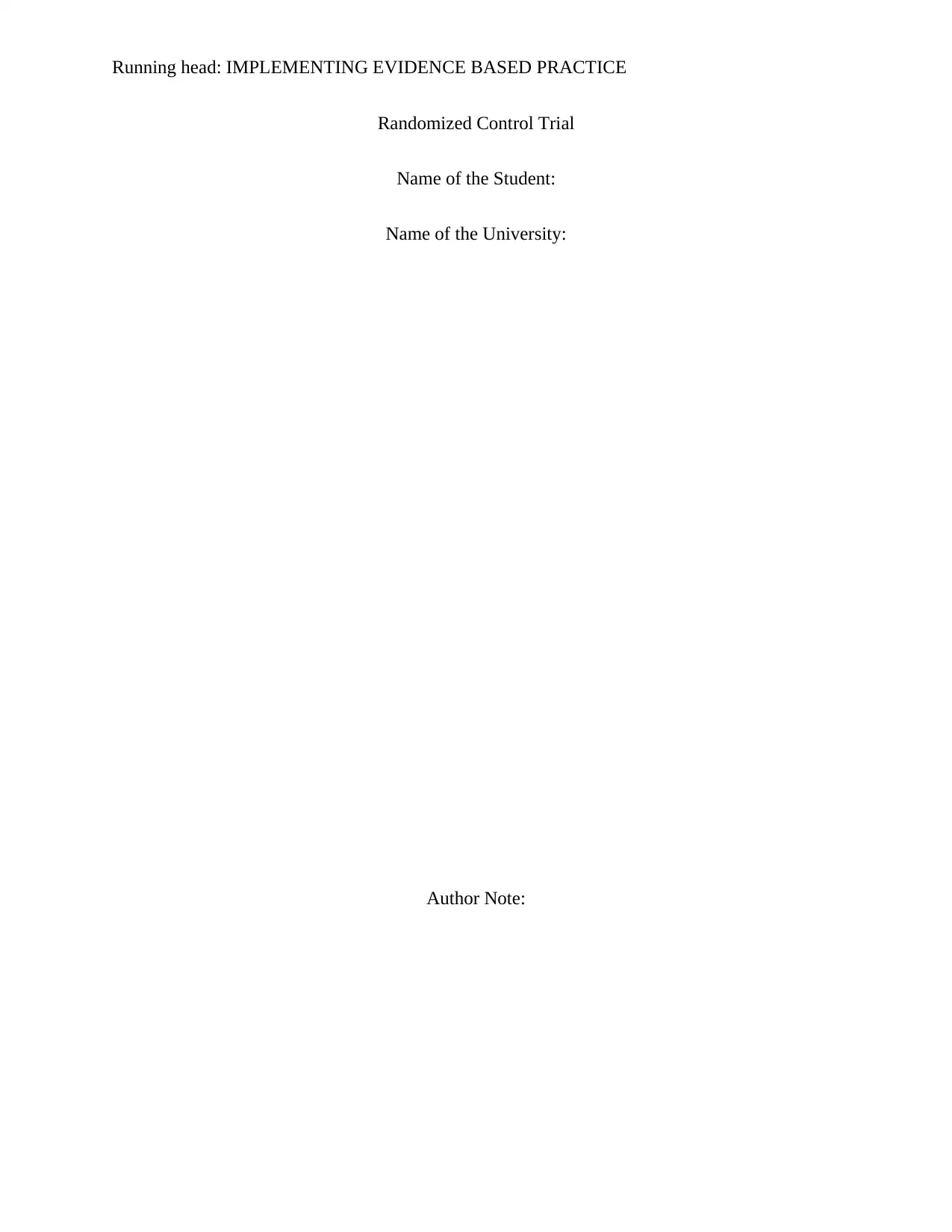
Running head: IMPLEMENTING EVIDENCE BASED PRACTICE
Randomized Control Trial
Name of the Student:
Name of the University:
Author Note:
Randomized Control Trial
Name of the Student:
Name of the University:
Author Note:
Paraphrase This Document
Need a fresh take? Get an instant paraphrase of this document with our AI Paraphraser
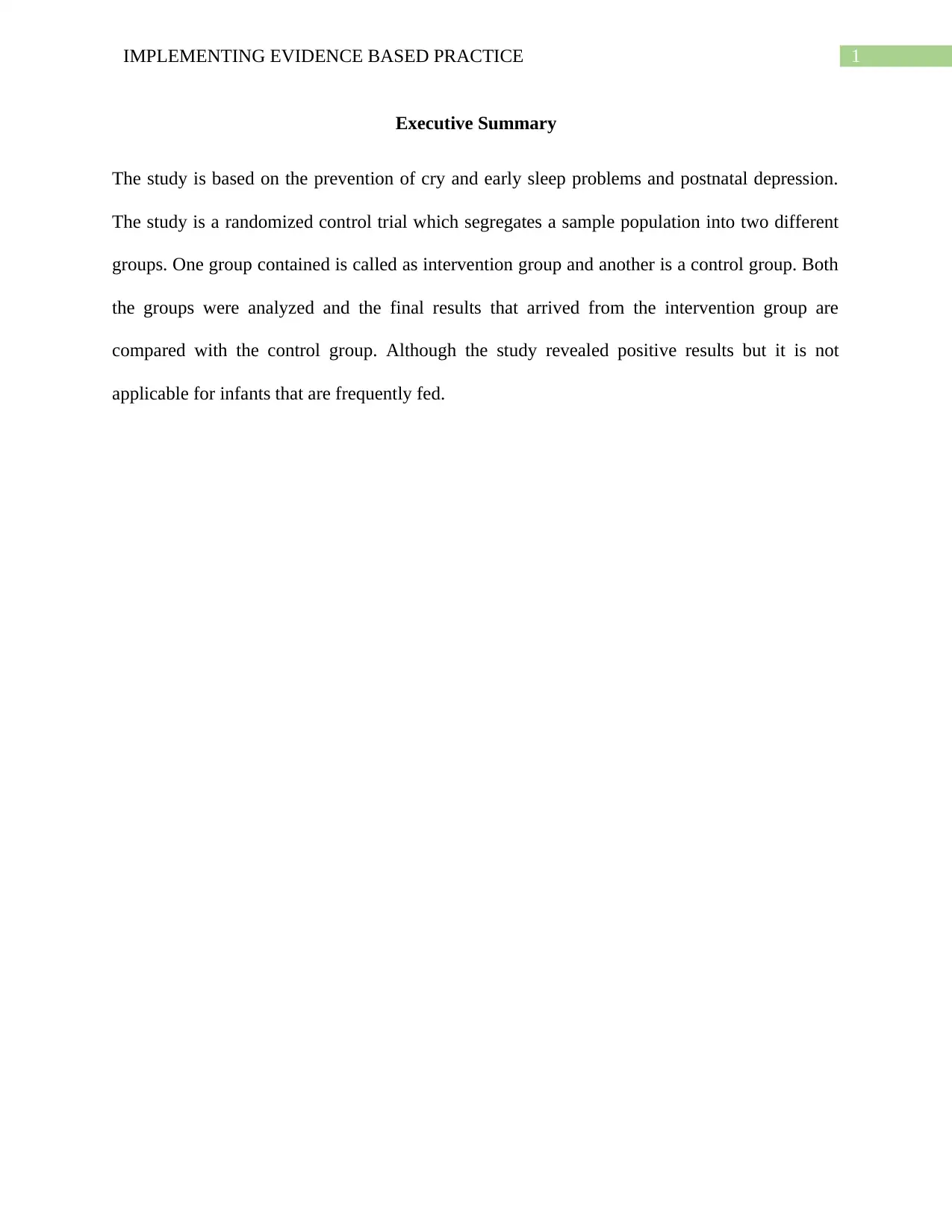
1IMPLEMENTING EVIDENCE BASED PRACTICE
Executive Summary
The study is based on the prevention of cry and early sleep problems and postnatal depression.
The study is a randomized control trial which segregates a sample population into two different
groups. One group contained is called as intervention group and another is a control group. Both
the groups were analyzed and the final results that arrived from the intervention group are
compared with the control group. Although the study revealed positive results but it is not
applicable for infants that are frequently fed.
Executive Summary
The study is based on the prevention of cry and early sleep problems and postnatal depression.
The study is a randomized control trial which segregates a sample population into two different
groups. One group contained is called as intervention group and another is a control group. Both
the groups were analyzed and the final results that arrived from the intervention group are
compared with the control group. Although the study revealed positive results but it is not
applicable for infants that are frequently fed.
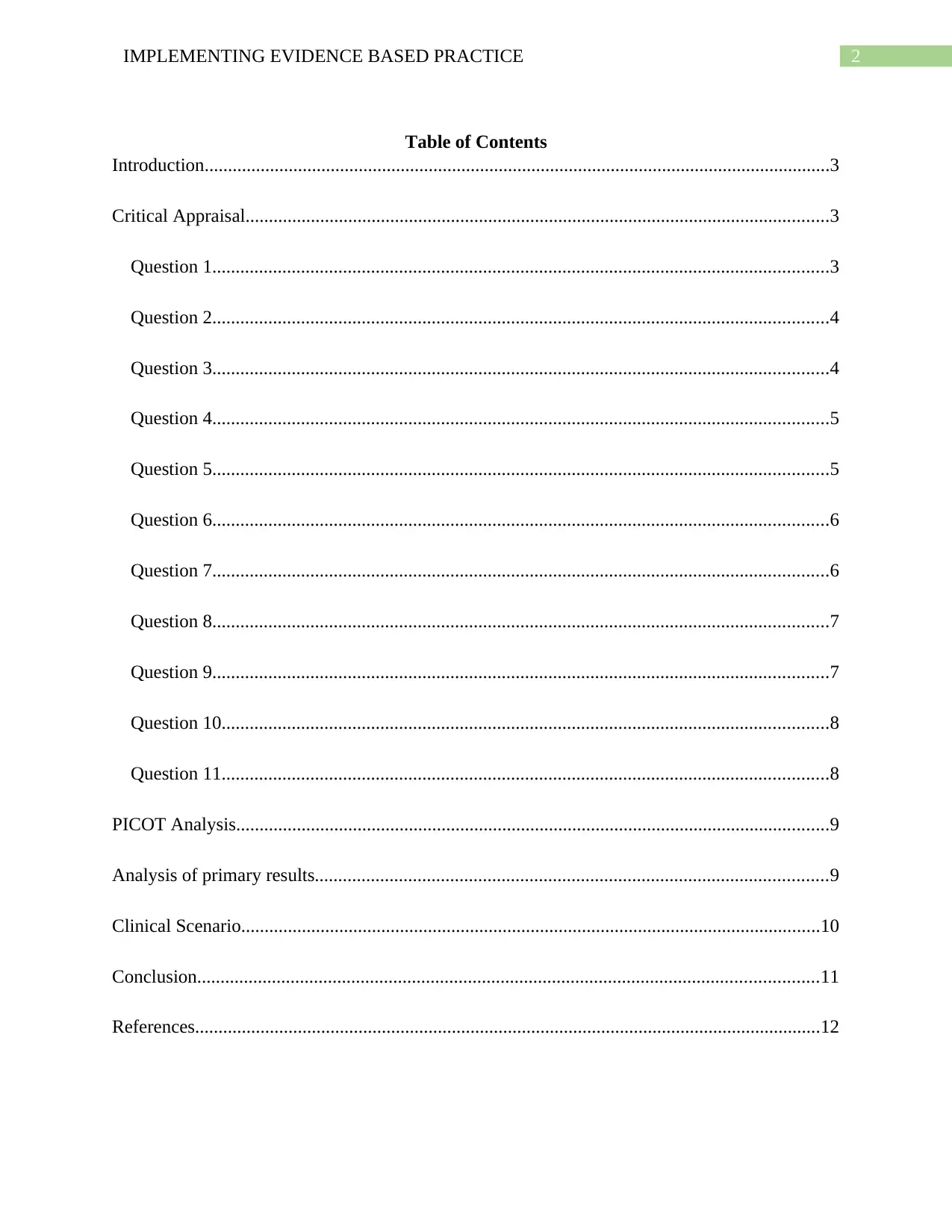
2IMPLEMENTING EVIDENCE BASED PRACTICE
Table of Contents
Introduction......................................................................................................................................3
Critical Appraisal.............................................................................................................................3
Question 1....................................................................................................................................3
Question 2....................................................................................................................................4
Question 3....................................................................................................................................4
Question 4....................................................................................................................................5
Question 5....................................................................................................................................5
Question 6....................................................................................................................................6
Question 7....................................................................................................................................6
Question 8....................................................................................................................................7
Question 9....................................................................................................................................7
Question 10..................................................................................................................................8
Question 11..................................................................................................................................8
PICOT Analysis...............................................................................................................................9
Analysis of primary results..............................................................................................................9
Clinical Scenario............................................................................................................................10
Conclusion.....................................................................................................................................11
References......................................................................................................................................12
Table of Contents
Introduction......................................................................................................................................3
Critical Appraisal.............................................................................................................................3
Question 1....................................................................................................................................3
Question 2....................................................................................................................................4
Question 3....................................................................................................................................4
Question 4....................................................................................................................................5
Question 5....................................................................................................................................5
Question 6....................................................................................................................................6
Question 7....................................................................................................................................6
Question 8....................................................................................................................................7
Question 9....................................................................................................................................7
Question 10..................................................................................................................................8
Question 11..................................................................................................................................8
PICOT Analysis...............................................................................................................................9
Analysis of primary results..............................................................................................................9
Clinical Scenario............................................................................................................................10
Conclusion.....................................................................................................................................11
References......................................................................................................................................12
⊘ This is a preview!⊘
Do you want full access?
Subscribe today to unlock all pages.

Trusted by 1+ million students worldwide
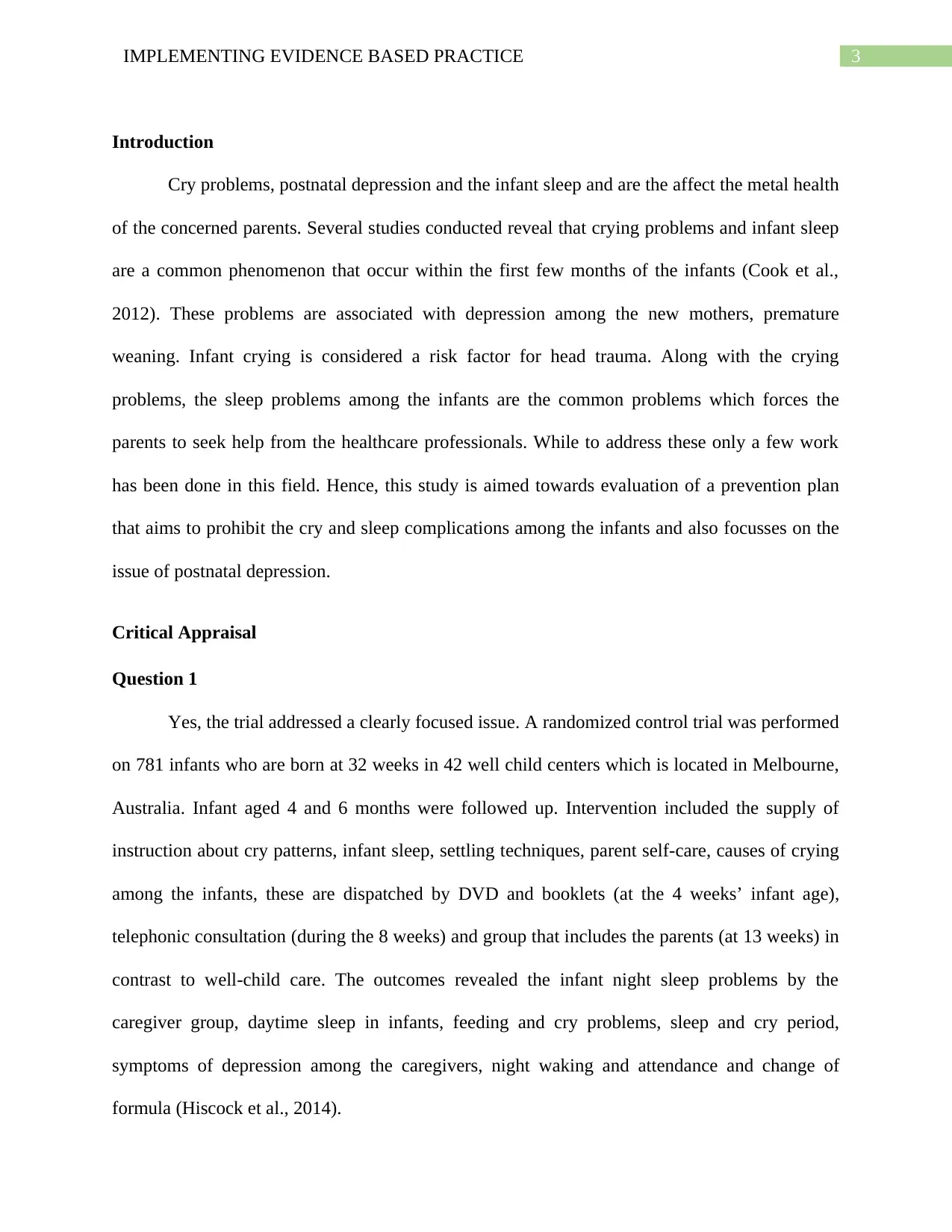
3IMPLEMENTING EVIDENCE BASED PRACTICE
Introduction
Cry problems, postnatal depression and the infant sleep and are the affect the metal health
of the concerned parents. Several studies conducted reveal that crying problems and infant sleep
are a common phenomenon that occur within the first few months of the infants (Cook et al.,
2012). These problems are associated with depression among the new mothers, premature
weaning. Infant crying is considered a risk factor for head trauma. Along with the crying
problems, the sleep problems among the infants are the common problems which forces the
parents to seek help from the healthcare professionals. While to address these only a few work
has been done in this field. Hence, this study is aimed towards evaluation of a prevention plan
that aims to prohibit the cry and sleep complications among the infants and also focusses on the
issue of postnatal depression.
Critical Appraisal
Question 1
Yes, the trial addressed a clearly focused issue. A randomized control trial was performed
on 781 infants who are born at 32 weeks in 42 well child centers which is located in Melbourne,
Australia. Infant aged 4 and 6 months were followed up. Intervention included the supply of
instruction about cry patterns, infant sleep, settling techniques, parent self-care, causes of crying
among the infants, these are dispatched by DVD and booklets (at the 4 weeks’ infant age),
telephonic consultation (during the 8 weeks) and group that includes the parents (at 13 weeks) in
contrast to well-child care. The outcomes revealed the infant night sleep problems by the
caregiver group, daytime sleep in infants, feeding and cry problems, sleep and cry period,
symptoms of depression among the caregivers, night waking and attendance and change of
formula (Hiscock et al., 2014).
Introduction
Cry problems, postnatal depression and the infant sleep and are the affect the metal health
of the concerned parents. Several studies conducted reveal that crying problems and infant sleep
are a common phenomenon that occur within the first few months of the infants (Cook et al.,
2012). These problems are associated with depression among the new mothers, premature
weaning. Infant crying is considered a risk factor for head trauma. Along with the crying
problems, the sleep problems among the infants are the common problems which forces the
parents to seek help from the healthcare professionals. While to address these only a few work
has been done in this field. Hence, this study is aimed towards evaluation of a prevention plan
that aims to prohibit the cry and sleep complications among the infants and also focusses on the
issue of postnatal depression.
Critical Appraisal
Question 1
Yes, the trial addressed a clearly focused issue. A randomized control trial was performed
on 781 infants who are born at 32 weeks in 42 well child centers which is located in Melbourne,
Australia. Infant aged 4 and 6 months were followed up. Intervention included the supply of
instruction about cry patterns, infant sleep, settling techniques, parent self-care, causes of crying
among the infants, these are dispatched by DVD and booklets (at the 4 weeks’ infant age),
telephonic consultation (during the 8 weeks) and group that includes the parents (at 13 weeks) in
contrast to well-child care. The outcomes revealed the infant night sleep problems by the
caregiver group, daytime sleep in infants, feeding and cry problems, sleep and cry period,
symptoms of depression among the caregivers, night waking and attendance and change of
formula (Hiscock et al., 2014).
Paraphrase This Document
Need a fresh take? Get an instant paraphrase of this document with our AI Paraphraser
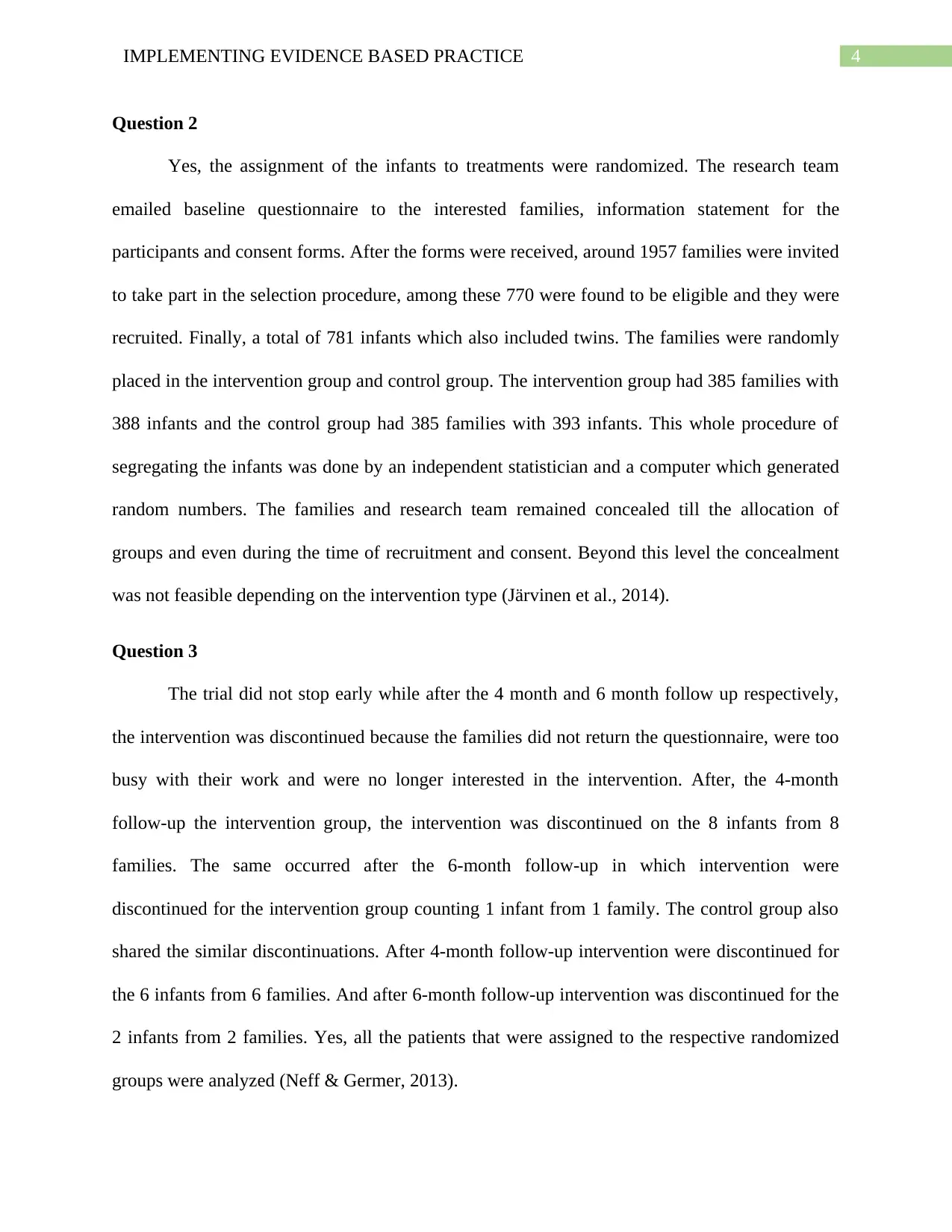
4IMPLEMENTING EVIDENCE BASED PRACTICE
Question 2
Yes, the assignment of the infants to treatments were randomized. The research team
emailed baseline questionnaire to the interested families, information statement for the
participants and consent forms. After the forms were received, around 1957 families were invited
to take part in the selection procedure, among these 770 were found to be eligible and they were
recruited. Finally, a total of 781 infants which also included twins. The families were randomly
placed in the intervention group and control group. The intervention group had 385 families with
388 infants and the control group had 385 families with 393 infants. This whole procedure of
segregating the infants was done by an independent statistician and a computer which generated
random numbers. The families and research team remained concealed till the allocation of
groups and even during the time of recruitment and consent. Beyond this level the concealment
was not feasible depending on the intervention type (Järvinen et al., 2014).
Question 3
The trial did not stop early while after the 4 month and 6 month follow up respectively,
the intervention was discontinued because the families did not return the questionnaire, were too
busy with their work and were no longer interested in the intervention. After, the 4-month
follow-up the intervention group, the intervention was discontinued on the 8 infants from 8
families. The same occurred after the 6-month follow-up in which intervention were
discontinued for the intervention group counting 1 infant from 1 family. The control group also
shared the similar discontinuations. After 4-month follow-up intervention were discontinued for
the 6 infants from 6 families. And after 6-month follow-up intervention was discontinued for the
2 infants from 2 families. Yes, all the patients that were assigned to the respective randomized
groups were analyzed (Neff & Germer, 2013).
Question 2
Yes, the assignment of the infants to treatments were randomized. The research team
emailed baseline questionnaire to the interested families, information statement for the
participants and consent forms. After the forms were received, around 1957 families were invited
to take part in the selection procedure, among these 770 were found to be eligible and they were
recruited. Finally, a total of 781 infants which also included twins. The families were randomly
placed in the intervention group and control group. The intervention group had 385 families with
388 infants and the control group had 385 families with 393 infants. This whole procedure of
segregating the infants was done by an independent statistician and a computer which generated
random numbers. The families and research team remained concealed till the allocation of
groups and even during the time of recruitment and consent. Beyond this level the concealment
was not feasible depending on the intervention type (Järvinen et al., 2014).
Question 3
The trial did not stop early while after the 4 month and 6 month follow up respectively,
the intervention was discontinued because the families did not return the questionnaire, were too
busy with their work and were no longer interested in the intervention. After, the 4-month
follow-up the intervention group, the intervention was discontinued on the 8 infants from 8
families. The same occurred after the 6-month follow-up in which intervention were
discontinued for the intervention group counting 1 infant from 1 family. The control group also
shared the similar discontinuations. After 4-month follow-up intervention were discontinued for
the 6 infants from 6 families. And after 6-month follow-up intervention was discontinued for the
2 infants from 2 families. Yes, all the patients that were assigned to the respective randomized
groups were analyzed (Neff & Germer, 2013).
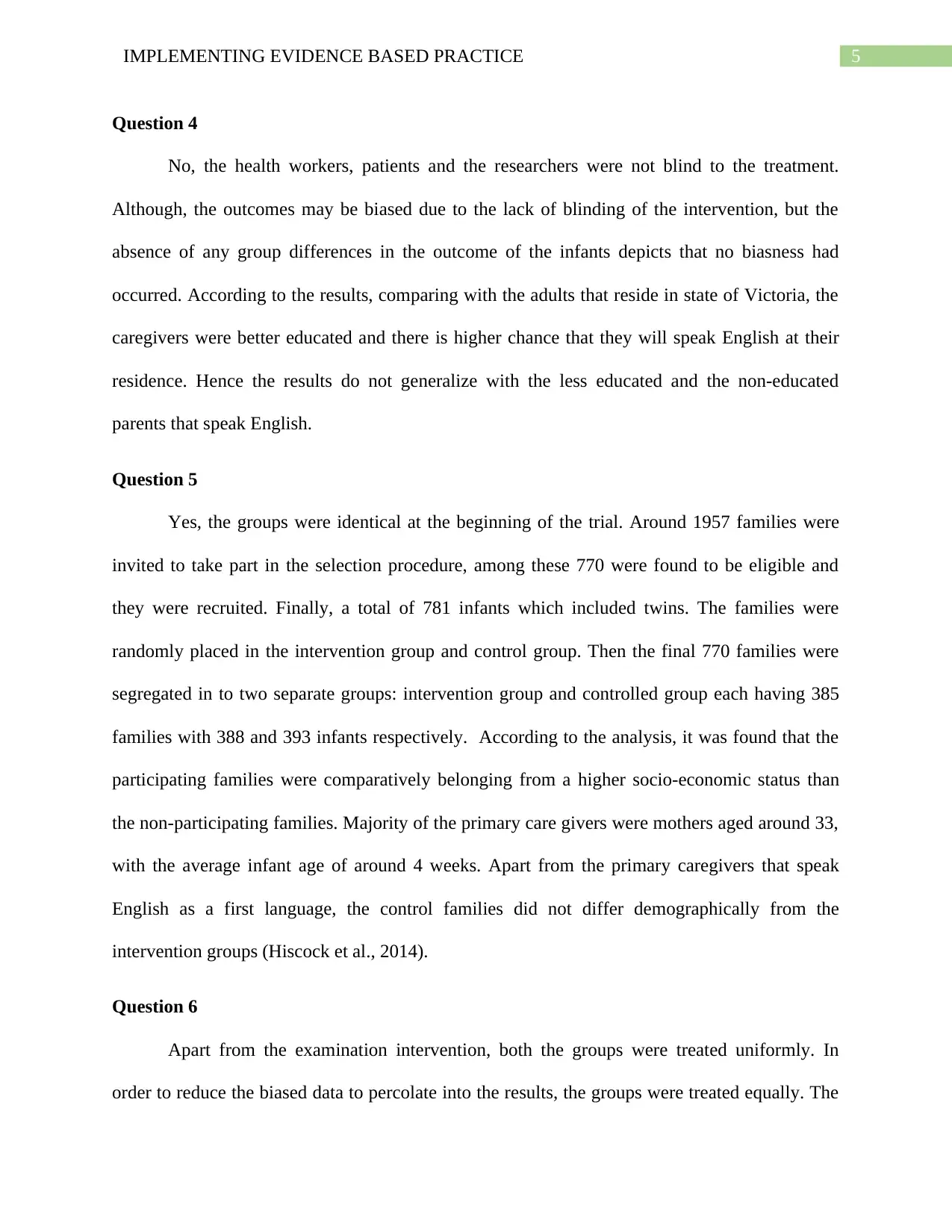
5IMPLEMENTING EVIDENCE BASED PRACTICE
Question 4
No, the health workers, patients and the researchers were not blind to the treatment.
Although, the outcomes may be biased due to the lack of blinding of the intervention, but the
absence of any group differences in the outcome of the infants depicts that no biasness had
occurred. According to the results, comparing with the adults that reside in state of Victoria, the
caregivers were better educated and there is higher chance that they will speak English at their
residence. Hence the results do not generalize with the less educated and the non-educated
parents that speak English.
Question 5
Yes, the groups were identical at the beginning of the trial. Around 1957 families were
invited to take part in the selection procedure, among these 770 were found to be eligible and
they were recruited. Finally, a total of 781 infants which included twins. The families were
randomly placed in the intervention group and control group. Then the final 770 families were
segregated in to two separate groups: intervention group and controlled group each having 385
families with 388 and 393 infants respectively. According to the analysis, it was found that the
participating families were comparatively belonging from a higher socio-economic status than
the non-participating families. Majority of the primary care givers were mothers aged around 33,
with the average infant age of around 4 weeks. Apart from the primary caregivers that speak
English as a first language, the control families did not differ demographically from the
intervention groups (Hiscock et al., 2014).
Question 6
Apart from the examination intervention, both the groups were treated uniformly. In
order to reduce the biased data to percolate into the results, the groups were treated equally. The
Question 4
No, the health workers, patients and the researchers were not blind to the treatment.
Although, the outcomes may be biased due to the lack of blinding of the intervention, but the
absence of any group differences in the outcome of the infants depicts that no biasness had
occurred. According to the results, comparing with the adults that reside in state of Victoria, the
caregivers were better educated and there is higher chance that they will speak English at their
residence. Hence the results do not generalize with the less educated and the non-educated
parents that speak English.
Question 5
Yes, the groups were identical at the beginning of the trial. Around 1957 families were
invited to take part in the selection procedure, among these 770 were found to be eligible and
they were recruited. Finally, a total of 781 infants which included twins. The families were
randomly placed in the intervention group and control group. Then the final 770 families were
segregated in to two separate groups: intervention group and controlled group each having 385
families with 388 and 393 infants respectively. According to the analysis, it was found that the
participating families were comparatively belonging from a higher socio-economic status than
the non-participating families. Majority of the primary care givers were mothers aged around 33,
with the average infant age of around 4 weeks. Apart from the primary caregivers that speak
English as a first language, the control families did not differ demographically from the
intervention groups (Hiscock et al., 2014).
Question 6
Apart from the examination intervention, both the groups were treated uniformly. In
order to reduce the biased data to percolate into the results, the groups were treated equally. The
⊘ This is a preview!⊘
Do you want full access?
Subscribe today to unlock all pages.

Trusted by 1+ million students worldwide
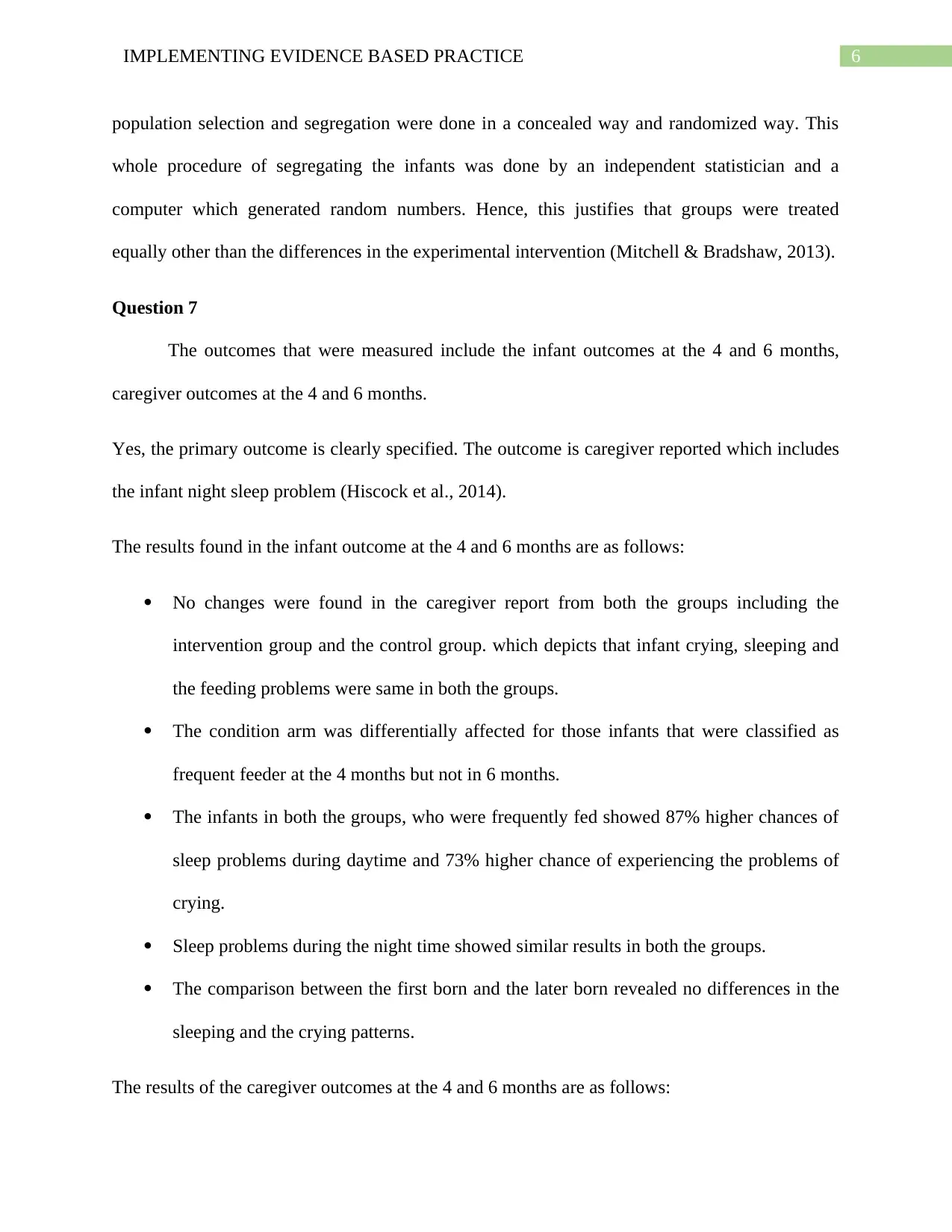
6IMPLEMENTING EVIDENCE BASED PRACTICE
population selection and segregation were done in a concealed way and randomized way. This
whole procedure of segregating the infants was done by an independent statistician and a
computer which generated random numbers. Hence, this justifies that groups were treated
equally other than the differences in the experimental intervention (Mitchell & Bradshaw, 2013).
Question 7
The outcomes that were measured include the infant outcomes at the 4 and 6 months,
caregiver outcomes at the 4 and 6 months.
Yes, the primary outcome is clearly specified. The outcome is caregiver reported which includes
the infant night sleep problem (Hiscock et al., 2014).
The results found in the infant outcome at the 4 and 6 months are as follows:
No changes were found in the caregiver report from both the groups including the
intervention group and the control group. which depicts that infant crying, sleeping and
the feeding problems were same in both the groups.
The condition arm was differentially affected for those infants that were classified as
frequent feeder at the 4 months but not in 6 months.
The infants in both the groups, who were frequently fed showed 87% higher chances of
sleep problems during daytime and 73% higher chance of experiencing the problems of
crying.
Sleep problems during the night time showed similar results in both the groups.
The comparison between the first born and the later born revealed no differences in the
sleeping and the crying patterns.
The results of the caregiver outcomes at the 4 and 6 months are as follows:
population selection and segregation were done in a concealed way and randomized way. This
whole procedure of segregating the infants was done by an independent statistician and a
computer which generated random numbers. Hence, this justifies that groups were treated
equally other than the differences in the experimental intervention (Mitchell & Bradshaw, 2013).
Question 7
The outcomes that were measured include the infant outcomes at the 4 and 6 months,
caregiver outcomes at the 4 and 6 months.
Yes, the primary outcome is clearly specified. The outcome is caregiver reported which includes
the infant night sleep problem (Hiscock et al., 2014).
The results found in the infant outcome at the 4 and 6 months are as follows:
No changes were found in the caregiver report from both the groups including the
intervention group and the control group. which depicts that infant crying, sleeping and
the feeding problems were same in both the groups.
The condition arm was differentially affected for those infants that were classified as
frequent feeder at the 4 months but not in 6 months.
The infants in both the groups, who were frequently fed showed 87% higher chances of
sleep problems during daytime and 73% higher chance of experiencing the problems of
crying.
Sleep problems during the night time showed similar results in both the groups.
The comparison between the first born and the later born revealed no differences in the
sleeping and the crying patterns.
The results of the caregiver outcomes at the 4 and 6 months are as follows:
Paraphrase This Document
Need a fresh take? Get an instant paraphrase of this document with our AI Paraphraser
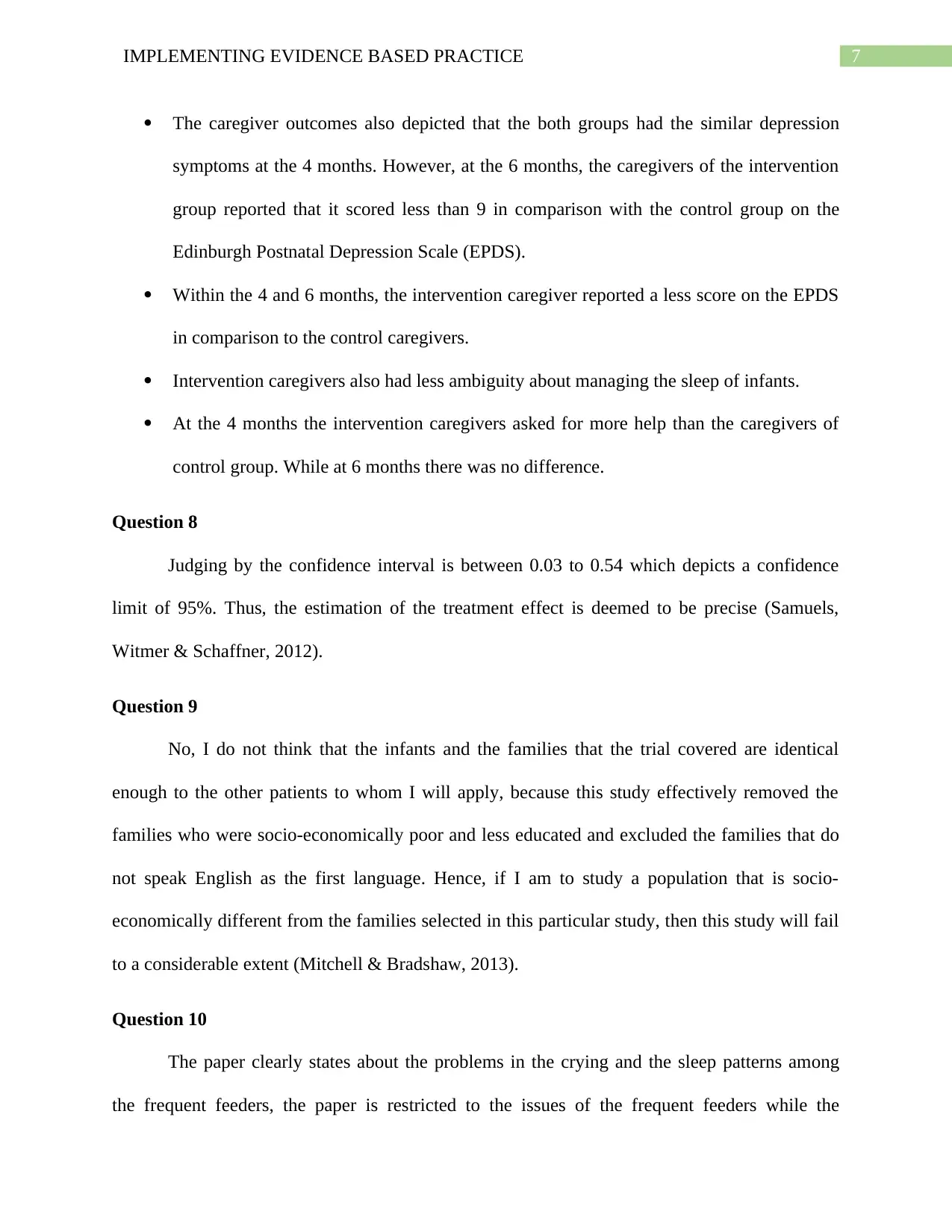
7IMPLEMENTING EVIDENCE BASED PRACTICE
The caregiver outcomes also depicted that the both groups had the similar depression
symptoms at the 4 months. However, at the 6 months, the caregivers of the intervention
group reported that it scored less than 9 in comparison with the control group on the
Edinburgh Postnatal Depression Scale (EPDS).
Within the 4 and 6 months, the intervention caregiver reported a less score on the EPDS
in comparison to the control caregivers.
Intervention caregivers also had less ambiguity about managing the sleep of infants.
At the 4 months the intervention caregivers asked for more help than the caregivers of
control group. While at 6 months there was no difference.
Question 8
Judging by the confidence interval is between 0.03 to 0.54 which depicts a confidence
limit of 95%. Thus, the estimation of the treatment effect is deemed to be precise (Samuels,
Witmer & Schaffner, 2012).
Question 9
No, I do not think that the infants and the families that the trial covered are identical
enough to the other patients to whom I will apply, because this study effectively removed the
families who were socio-economically poor and less educated and excluded the families that do
not speak English as the first language. Hence, if I am to study a population that is socio-
economically different from the families selected in this particular study, then this study will fail
to a considerable extent (Mitchell & Bradshaw, 2013).
Question 10
The paper clearly states about the problems in the crying and the sleep patterns among
the frequent feeders, the paper is restricted to the issues of the frequent feeders while the
The caregiver outcomes also depicted that the both groups had the similar depression
symptoms at the 4 months. However, at the 6 months, the caregivers of the intervention
group reported that it scored less than 9 in comparison with the control group on the
Edinburgh Postnatal Depression Scale (EPDS).
Within the 4 and 6 months, the intervention caregiver reported a less score on the EPDS
in comparison to the control caregivers.
Intervention caregivers also had less ambiguity about managing the sleep of infants.
At the 4 months the intervention caregivers asked for more help than the caregivers of
control group. While at 6 months there was no difference.
Question 8
Judging by the confidence interval is between 0.03 to 0.54 which depicts a confidence
limit of 95%. Thus, the estimation of the treatment effect is deemed to be precise (Samuels,
Witmer & Schaffner, 2012).
Question 9
No, I do not think that the infants and the families that the trial covered are identical
enough to the other patients to whom I will apply, because this study effectively removed the
families who were socio-economically poor and less educated and excluded the families that do
not speak English as the first language. Hence, if I am to study a population that is socio-
economically different from the families selected in this particular study, then this study will fail
to a considerable extent (Mitchell & Bradshaw, 2013).
Question 10
The paper clearly states about the problems in the crying and the sleep patterns among
the frequent feeders, the paper is restricted to the issues of the frequent feeders while the
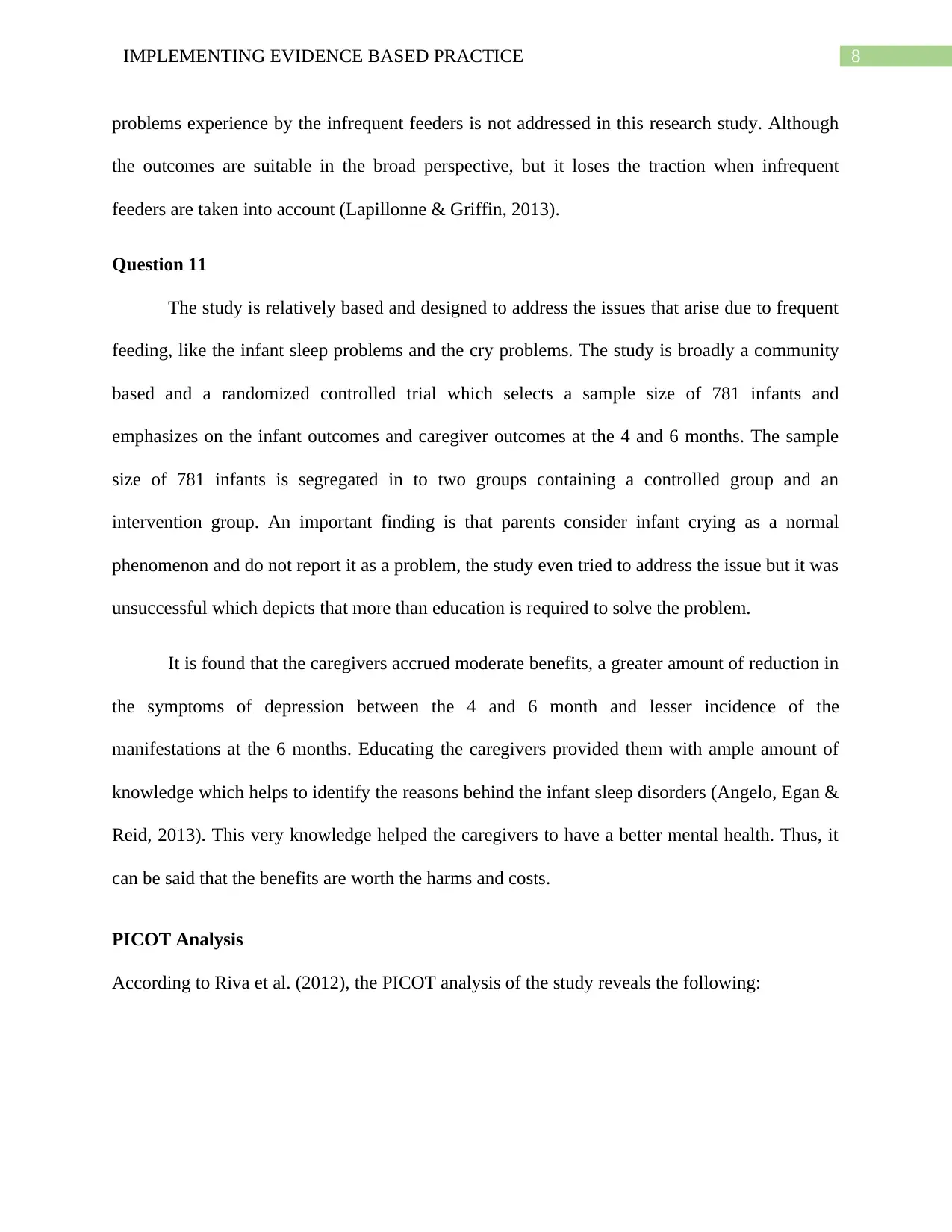
8IMPLEMENTING EVIDENCE BASED PRACTICE
problems experience by the infrequent feeders is not addressed in this research study. Although
the outcomes are suitable in the broad perspective, but it loses the traction when infrequent
feeders are taken into account (Lapillonne & Griffin, 2013).
Question 11
The study is relatively based and designed to address the issues that arise due to frequent
feeding, like the infant sleep problems and the cry problems. The study is broadly a community
based and a randomized controlled trial which selects a sample size of 781 infants and
emphasizes on the infant outcomes and caregiver outcomes at the 4 and 6 months. The sample
size of 781 infants is segregated in to two groups containing a controlled group and an
intervention group. An important finding is that parents consider infant crying as a normal
phenomenon and do not report it as a problem, the study even tried to address the issue but it was
unsuccessful which depicts that more than education is required to solve the problem.
It is found that the caregivers accrued moderate benefits, a greater amount of reduction in
the symptoms of depression between the 4 and 6 month and lesser incidence of the
manifestations at the 6 months. Educating the caregivers provided them with ample amount of
knowledge which helps to identify the reasons behind the infant sleep disorders (Angelo, Egan &
Reid, 2013). This very knowledge helped the caregivers to have a better mental health. Thus, it
can be said that the benefits are worth the harms and costs.
PICOT Analysis
According to Riva et al. (2012), the PICOT analysis of the study reveals the following:
problems experience by the infrequent feeders is not addressed in this research study. Although
the outcomes are suitable in the broad perspective, but it loses the traction when infrequent
feeders are taken into account (Lapillonne & Griffin, 2013).
Question 11
The study is relatively based and designed to address the issues that arise due to frequent
feeding, like the infant sleep problems and the cry problems. The study is broadly a community
based and a randomized controlled trial which selects a sample size of 781 infants and
emphasizes on the infant outcomes and caregiver outcomes at the 4 and 6 months. The sample
size of 781 infants is segregated in to two groups containing a controlled group and an
intervention group. An important finding is that parents consider infant crying as a normal
phenomenon and do not report it as a problem, the study even tried to address the issue but it was
unsuccessful which depicts that more than education is required to solve the problem.
It is found that the caregivers accrued moderate benefits, a greater amount of reduction in
the symptoms of depression between the 4 and 6 month and lesser incidence of the
manifestations at the 6 months. Educating the caregivers provided them with ample amount of
knowledge which helps to identify the reasons behind the infant sleep disorders (Angelo, Egan &
Reid, 2013). This very knowledge helped the caregivers to have a better mental health. Thus, it
can be said that the benefits are worth the harms and costs.
PICOT Analysis
According to Riva et al. (2012), the PICOT analysis of the study reveals the following:
⊘ This is a preview!⊘
Do you want full access?
Subscribe today to unlock all pages.

Trusted by 1+ million students worldwide
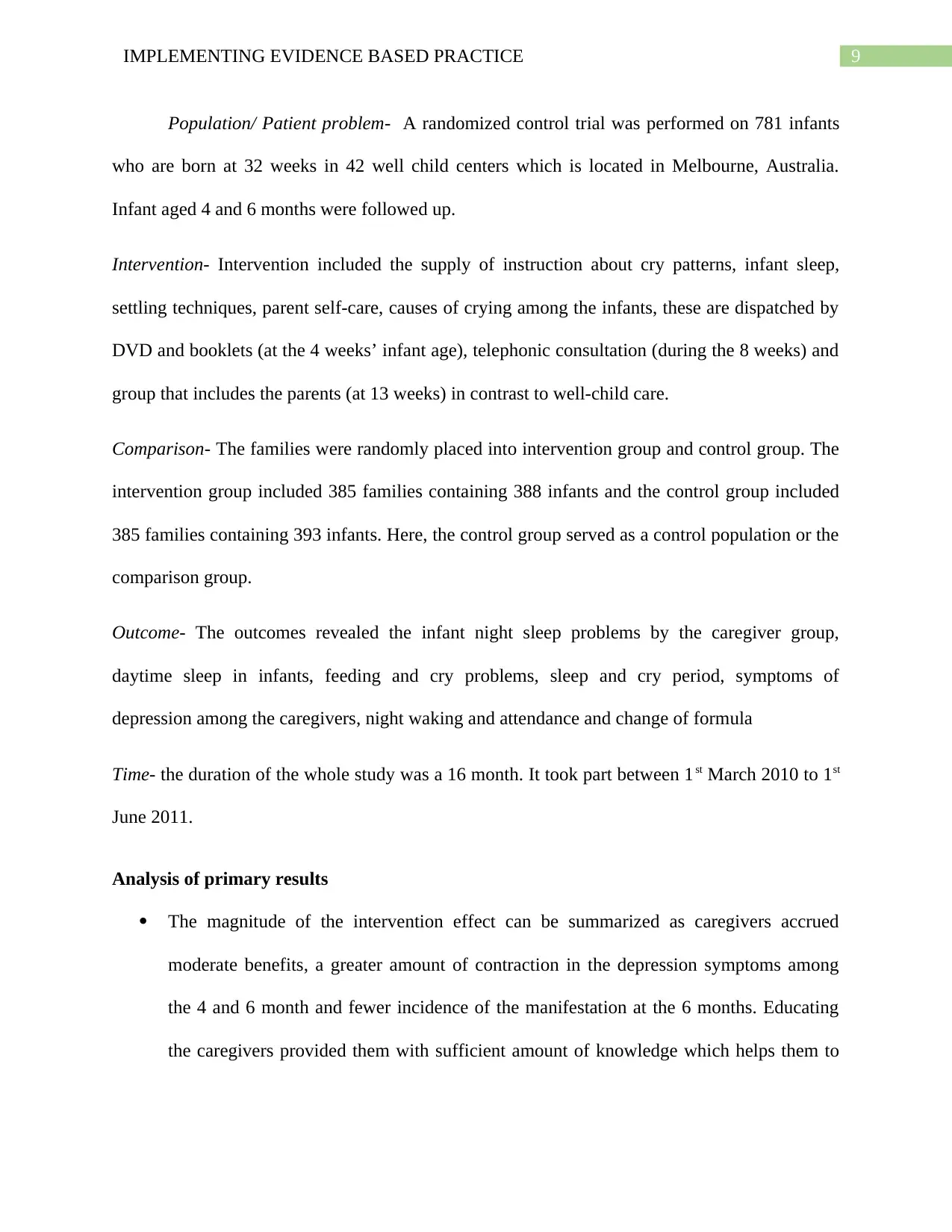
9IMPLEMENTING EVIDENCE BASED PRACTICE
Population/ Patient problem- A randomized control trial was performed on 781 infants
who are born at 32 weeks in 42 well child centers which is located in Melbourne, Australia.
Infant aged 4 and 6 months were followed up.
Intervention- Intervention included the supply of instruction about cry patterns, infant sleep,
settling techniques, parent self-care, causes of crying among the infants, these are dispatched by
DVD and booklets (at the 4 weeks’ infant age), telephonic consultation (during the 8 weeks) and
group that includes the parents (at 13 weeks) in contrast to well-child care.
Comparison- The families were randomly placed into intervention group and control group. The
intervention group included 385 families containing 388 infants and the control group included
385 families containing 393 infants. Here, the control group served as a control population or the
comparison group.
Outcome- The outcomes revealed the infant night sleep problems by the caregiver group,
daytime sleep in infants, feeding and cry problems, sleep and cry period, symptoms of
depression among the caregivers, night waking and attendance and change of formula
Time- the duration of the whole study was a 16 month. It took part between 1st March 2010 to 1st
June 2011.
Analysis of primary results
The magnitude of the intervention effect can be summarized as caregivers accrued
moderate benefits, a greater amount of contraction in the depression symptoms among
the 4 and 6 month and fewer incidence of the manifestation at the 6 months. Educating
the caregivers provided them with sufficient amount of knowledge which helps them to
Population/ Patient problem- A randomized control trial was performed on 781 infants
who are born at 32 weeks in 42 well child centers which is located in Melbourne, Australia.
Infant aged 4 and 6 months were followed up.
Intervention- Intervention included the supply of instruction about cry patterns, infant sleep,
settling techniques, parent self-care, causes of crying among the infants, these are dispatched by
DVD and booklets (at the 4 weeks’ infant age), telephonic consultation (during the 8 weeks) and
group that includes the parents (at 13 weeks) in contrast to well-child care.
Comparison- The families were randomly placed into intervention group and control group. The
intervention group included 385 families containing 388 infants and the control group included
385 families containing 393 infants. Here, the control group served as a control population or the
comparison group.
Outcome- The outcomes revealed the infant night sleep problems by the caregiver group,
daytime sleep in infants, feeding and cry problems, sleep and cry period, symptoms of
depression among the caregivers, night waking and attendance and change of formula
Time- the duration of the whole study was a 16 month. It took part between 1st March 2010 to 1st
June 2011.
Analysis of primary results
The magnitude of the intervention effect can be summarized as caregivers accrued
moderate benefits, a greater amount of contraction in the depression symptoms among
the 4 and 6 month and fewer incidence of the manifestation at the 6 months. Educating
the caregivers provided them with sufficient amount of knowledge which helps them to
Paraphrase This Document
Need a fresh take? Get an instant paraphrase of this document with our AI Paraphraser
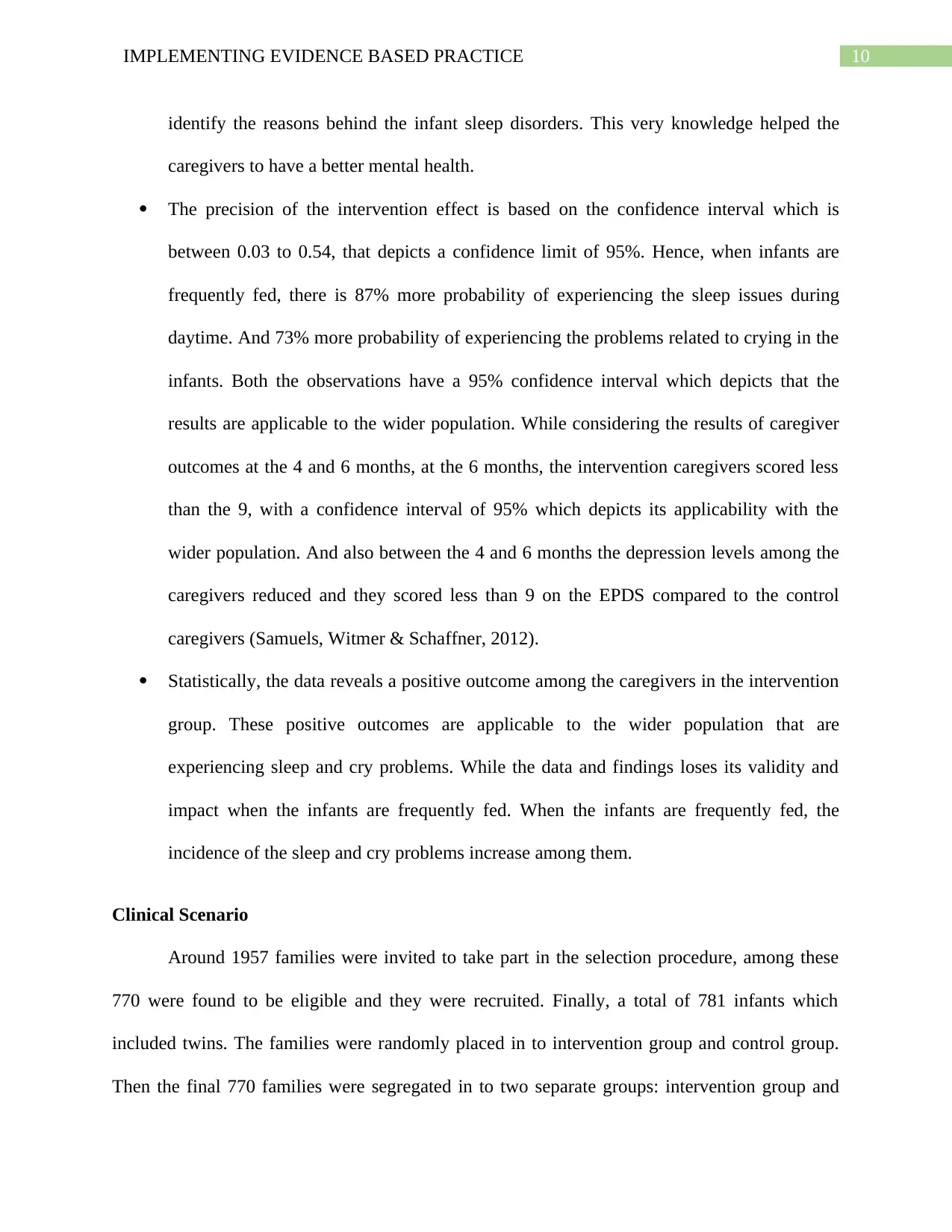
10IMPLEMENTING EVIDENCE BASED PRACTICE
identify the reasons behind the infant sleep disorders. This very knowledge helped the
caregivers to have a better mental health.
The precision of the intervention effect is based on the confidence interval which is
between 0.03 to 0.54, that depicts a confidence limit of 95%. Hence, when infants are
frequently fed, there is 87% more probability of experiencing the sleep issues during
daytime. And 73% more probability of experiencing the problems related to crying in the
infants. Both the observations have a 95% confidence interval which depicts that the
results are applicable to the wider population. While considering the results of caregiver
outcomes at the 4 and 6 months, at the 6 months, the intervention caregivers scored less
than the 9, with a confidence interval of 95% which depicts its applicability with the
wider population. And also between the 4 and 6 months the depression levels among the
caregivers reduced and they scored less than 9 on the EPDS compared to the control
caregivers (Samuels, Witmer & Schaffner, 2012).
Statistically, the data reveals a positive outcome among the caregivers in the intervention
group. These positive outcomes are applicable to the wider population that are
experiencing sleep and cry problems. While the data and findings loses its validity and
impact when the infants are frequently fed. When the infants are frequently fed, the
incidence of the sleep and cry problems increase among them.
Clinical Scenario
Around 1957 families were invited to take part in the selection procedure, among these
770 were found to be eligible and they were recruited. Finally, a total of 781 infants which
included twins. The families were randomly placed in to intervention group and control group.
Then the final 770 families were segregated in to two separate groups: intervention group and
identify the reasons behind the infant sleep disorders. This very knowledge helped the
caregivers to have a better mental health.
The precision of the intervention effect is based on the confidence interval which is
between 0.03 to 0.54, that depicts a confidence limit of 95%. Hence, when infants are
frequently fed, there is 87% more probability of experiencing the sleep issues during
daytime. And 73% more probability of experiencing the problems related to crying in the
infants. Both the observations have a 95% confidence interval which depicts that the
results are applicable to the wider population. While considering the results of caregiver
outcomes at the 4 and 6 months, at the 6 months, the intervention caregivers scored less
than the 9, with a confidence interval of 95% which depicts its applicability with the
wider population. And also between the 4 and 6 months the depression levels among the
caregivers reduced and they scored less than 9 on the EPDS compared to the control
caregivers (Samuels, Witmer & Schaffner, 2012).
Statistically, the data reveals a positive outcome among the caregivers in the intervention
group. These positive outcomes are applicable to the wider population that are
experiencing sleep and cry problems. While the data and findings loses its validity and
impact when the infants are frequently fed. When the infants are frequently fed, the
incidence of the sleep and cry problems increase among them.
Clinical Scenario
Around 1957 families were invited to take part in the selection procedure, among these
770 were found to be eligible and they were recruited. Finally, a total of 781 infants which
included twins. The families were randomly placed in to intervention group and control group.
Then the final 770 families were segregated in to two separate groups: intervention group and
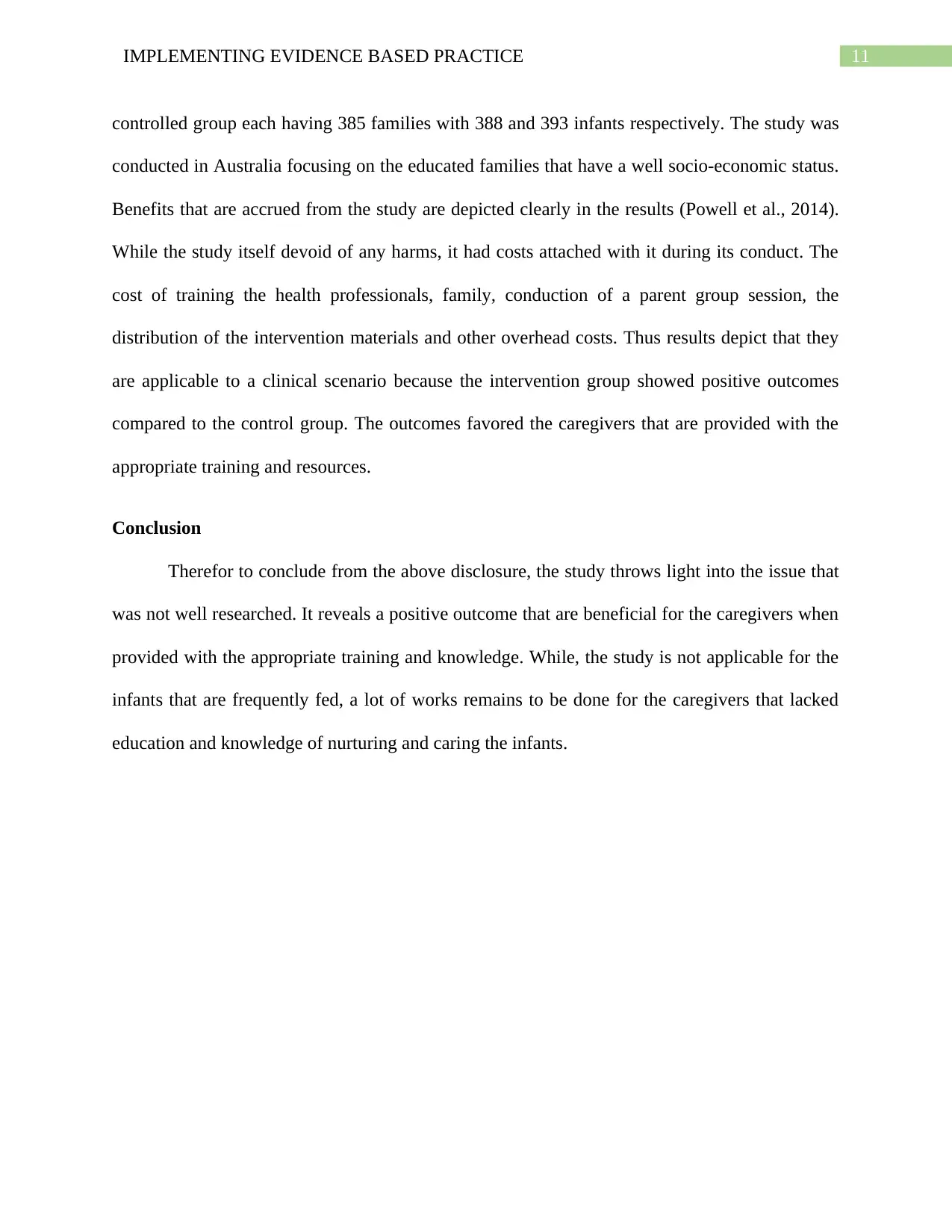
11IMPLEMENTING EVIDENCE BASED PRACTICE
controlled group each having 385 families with 388 and 393 infants respectively. The study was
conducted in Australia focusing on the educated families that have a well socio-economic status.
Benefits that are accrued from the study are depicted clearly in the results (Powell et al., 2014).
While the study itself devoid of any harms, it had costs attached with it during its conduct. The
cost of training the health professionals, family, conduction of a parent group session, the
distribution of the intervention materials and other overhead costs. Thus results depict that they
are applicable to a clinical scenario because the intervention group showed positive outcomes
compared to the control group. The outcomes favored the caregivers that are provided with the
appropriate training and resources.
Conclusion
Therefor to conclude from the above disclosure, the study throws light into the issue that
was not well researched. It reveals a positive outcome that are beneficial for the caregivers when
provided with the appropriate training and knowledge. While, the study is not applicable for the
infants that are frequently fed, a lot of works remains to be done for the caregivers that lacked
education and knowledge of nurturing and caring the infants.
controlled group each having 385 families with 388 and 393 infants respectively. The study was
conducted in Australia focusing on the educated families that have a well socio-economic status.
Benefits that are accrued from the study are depicted clearly in the results (Powell et al., 2014).
While the study itself devoid of any harms, it had costs attached with it during its conduct. The
cost of training the health professionals, family, conduction of a parent group session, the
distribution of the intervention materials and other overhead costs. Thus results depict that they
are applicable to a clinical scenario because the intervention group showed positive outcomes
compared to the control group. The outcomes favored the caregivers that are provided with the
appropriate training and resources.
Conclusion
Therefor to conclude from the above disclosure, the study throws light into the issue that
was not well researched. It reveals a positive outcome that are beneficial for the caregivers when
provided with the appropriate training and knowledge. While, the study is not applicable for the
infants that are frequently fed, a lot of works remains to be done for the caregivers that lacked
education and knowledge of nurturing and caring the infants.
⊘ This is a preview!⊘
Do you want full access?
Subscribe today to unlock all pages.

Trusted by 1+ million students worldwide
1 out of 14
Related Documents
Your All-in-One AI-Powered Toolkit for Academic Success.
+13062052269
info@desklib.com
Available 24*7 on WhatsApp / Email
![[object Object]](/_next/static/media/star-bottom.7253800d.svg)
Unlock your academic potential
Copyright © 2020–2025 A2Z Services. All Rights Reserved. Developed and managed by ZUCOL.





